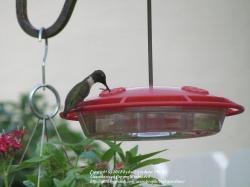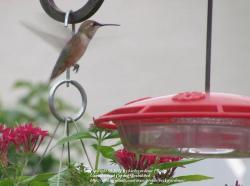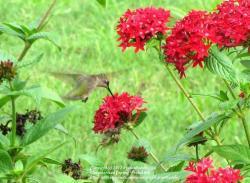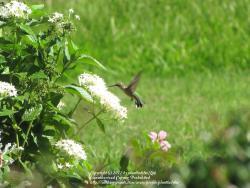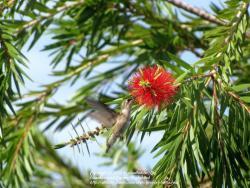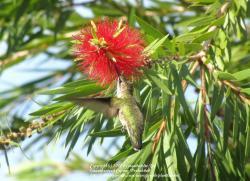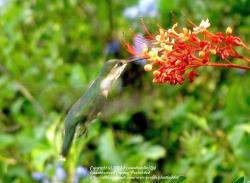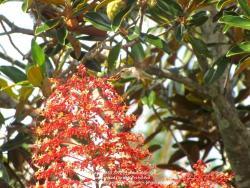I am posting this info here as many Florida gardeners may or may not be aware of hummingbirds in Florida. I would like to encourage gardeners to consider becoming a hummingbird host.
I am posting this information around the internet in hopes of getting more Florida gardeners and birders to host hummingbirds in their yard and report their sightings...
I wanted to post some information about hummingbirds in Florida on this thread:
There have been 11 different species of hummingbird sightings confirmed in Florida: Ruby-throated (being the most common), Rufous, Allen's, Black-chinned, Calliope, Bahama Woodstar, Buff-bellied, Anna's, Broad-billed, Broad-tailed, and White-eared Hummingbirds.
There are at least two different Ruby-throated hummingbird populations: There are the south-bound hummingbirds migrating into/through the state in the Fall/Winter and the Spring migrating hummingbirds heading north through the state in the Spring. These different populations have been sighted throughout Florida from the east coast to the west coast, from the northern part of the state down to the Keys! There is less data about any of the other hummingbird species sighted in Florida.
There are also some breeding Ruby-throated hummingbird populations during the Spring/Summer months sighted from central Florida up through north Florida. The breeding females and juvenile birds migrate in the Fall/Winter. Sightings info can be reported on the Florida Hummingbird Forum.
http://floridahummingbirds.pro...
This forum listed above was created to collect Florida hummingbird sightings data to provide a better awareness of the possibilities in Florida. Much is still unknown. More reports are needed. It would be great to hear from more folks who see hummers from south Florida and the Keys. ALL reports posted on the above website are appreciated and it gives all of us a better understanding of what is going on with the birds sighted here in Florida!
Contrary to some beliefs, there has been no proof to suggest that there are any non-migratory, resident Ruby-throated hummingbirds (RTHs) in Florida. So if you seem to have RTHs year round, it is likely different birds in Spring/Summer and Fall/Winter. Over-lap of migrating bird sightings are very possible.
Whether or not you see any hummers anytime during the year in Florida depends on if you have food and shelter to offer them and how long it takes for them to find you. I am a firm believer that if you plant it, they will come! Well-kept feeders are another very enticing way to attract them. Having both feeders and nectar plants as well as large trees for shelter are some of the necessities they will be looking for. If you have a good habitat, you may very well host one or more winter hummers that will hang around your area and frequent your yard for a season or two. The summer breeding birds typically don't nest near homes. Ruby-throated hummers often nest in trees near bodies of water (which offers protection from predators). But there may be exceptions.
For those new to hummingbird feeders, this is the recommended ingredients:
Non-colored sugar water which you can make using the ratio of 4 cups of water to 1 cup of white sugar. (Do NOT use honey, powdered sugar, brown sugar, or any other sweetener!) I personally recommend bottled "spring" water which can be purchased by the gallon at most grocery stores. Feeders should be thoroughly cleaned and fresh sugar water changed out every 2-3 days during the hot months and every 3-4 days during the colder months. Most of the sugar water will be wasted as you will probably only get a few birds using it. Here in Florida, lots of hummers swarming a feeder is rare. If your feeders are not properly maintained, the birds will not use them. It is a commitment to maintain clean and healthy feeders, but well worth it once the birds find you! It took me over 2 years to attract them to my yard all the while maintaining feeders every few days.
I am on the east coast of central Florida (city of Sebastian) and keep my feeders up year round. I have hummers all year except for two weeks/a month during the late summer when the Spring/Summer breeding RTHs leave and the Fall/Winter migrating hummers have yet to arrive. I truly believe it is because I have a good habitat in and around my yard and hang feeders that encourage them to stick around. I believe that the undeveloped woodland river areas in my town also contribute to the presence of breeding birds in summer!
The only species I've seen in my yard has been the Ruby-throated hummingbirds. But just this past week, I had the good fortune to witness a confirmed young female Rufous or Allen's hummingbird. There was no way to confirm for sure which bird species it was because the females of both species are very, very similar in appearance. It would probably require the ID to be made by a certified hummingbird bander, unless I was extremely lucky to get a very good close-up of her spread out tail feathers. This bird was likely hatched earlier this year somewhere between Oregon and Alaska, so it's amazing what hummer species we get here in the Sunshine State!
Typically, many of the birds will return to their season sites, so once you start getting them, you'll likely see them the following year unless they don't survive or the habitat changes in your area. (The removal of wooded areas and large trees may have a negative affect on new and returning birds.) Also weather conditions (such as hurricanes) can also affect their return.
If you sincerely want to attract hummingbirds to your yard, persistence and commitment is the key! Provide a good habitat and in time I'm quite sure you will see your first bird! The wait is well worth it!!!! Good luck to all current and future hummingbird hosts!
In posting this info, I hope it encourages and helps all folks in Florida (and other states, too) to consider becoming a host yard for these precious little flying jewels!
And on another note that might be of interest, if you have not seen the PBS full length video, "Hummingbirds: Magic in the Air", it is highly recommended:
http://video.pbs.org/video/138...
It can also be found on YouTube for folks inside as well as outside the USA who can't view the PBS video site:
http://www.youtube.com/watch?v...
I recently photographed an adult male Ruby-throated hummingbird I spotted in my yard on Sept. 8th and a young female Rufous or Allen's hummingbird photo capture taken on Sept 13th.
